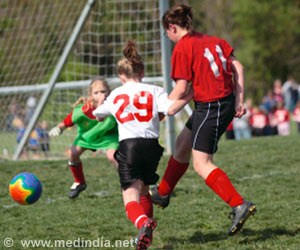A single season of contact sports in high school can result in brain changes among players regardless of clinical findings or concussion diagnosis.

‘Football has the highest concussion rate of any competitive contact sport, and there is growing concern about the effects of subconcussive head impacts.’





"Our findings add to a growing body of literature demonstrating that a single season of contact sports can result in brain changes regardless of clinical findings or concussion diagnosis," said senior author Dr. Joseph Maldjian, Chief of the Neuroradiology Division and Director of the Advanced Neuroscience Imaging Research Lab, part of the Peter O'Donnell Jr. Brain Institute at UT Southwestern. In the study, appearing in the Journal of Neurotrauma, a team of investigators at UT Southwestern, Wake Forest University Medical Center, and Children's National Medical Center evaluated about two dozen players over the course of a single football season. The group of players was not large enough to draw conclusions about the differences in impacts between positions, researchers said, and additional studies will be needed to determine what the deviations mean clinically for individuals.
"Studies like this are important to understand how and where long-term damage might be occurring, so that we can then take the necessary steps to prevent it," said first author Dr. Elizabeth Davenport, a postdoctoral researcher in the Department of Radiology and the Advanced Imaging Research Center at UT Southwestern. During the pre-season each player had an MRI scan and participated in cognitive testing, which included memory and reaction time tests. During the season they wore sensors in their helmets that detected each impact they received. Post-season, each player had another MRI scan and another round of cognitive tests.
Researchers then used diffusional kurtosis imaging (DKI), which measures water diffusion in biological cells, to identify changes in neural tissues. DKI analysis has been used to detect changes in neural tissues to study brain development, as well as brain injury and disease including autism spectrum disorders, attention deficit/hyperactivity disorder (ADHD), Alzheimer's disease, traumatic brain injury (TBI), stroke, schizophrenia, and mild cognitive impairment.
DKI also allowed the researchers to measure white matter abnormalities. White matter consists of fibers that connect brain cells and can speed or slow signaling between nerve cells. In order for the brain to reorganize connections, white matter must be intact and the degree of white matter damage may be one factor that limits the ability of the brain to reorganize connections following TBI.
Advertisement
Football has the highest concussion rate of any competitive contact sport, and there is growing concern - reflected in the recent decrease in participation in the Pop Warner youth football program - among parents, coaches, and physicians of youth athletes about the effects of subconcussive head impacts, those not directly resulting in a concussion diagnosis, researchers noted. Previous research has focused primarily on college football players, but recent studies have shown impact distributions for youth and high school players to be similar to those seen at the college level, with differences primarily in the highest impact magnitudes and total number of impacts, the researchers noted.
Advertisement
CON-TEX includes one of the nation's first registries of concussion patients ages 5 and older to capture comprehensive, longitudinal data on sports-related concussion and mild traumatic brain injury patients. The Texas Institute for Brain Injury and Repair (TIBIR), a state-funded initiative to promote innovative research and education in traumatic brain injury, includes a comprehensive Concussion Network that delivers expert brain injury education to coaches, school nurses, athletic trainers, and parents about the risks of sports-related injuries.
UT Southwestern established the Peter O'Donnell Jr. Brain Institute as a comprehensive initiative dedicated to better understanding the basic molecular workings of the brain and applying these discoveries to the prevention and treatment of brain diseases and injuries. Other researchers affiliated with the Peter O'Donnell Jr. Brain Institute are looking into the process of new neuron formation after TBI, neuronal replacement in functional recovery from brain injury, the neuropsychiatric and neurological effects of rotational brain injury, and more complete understanding of the interaction between white matter damage and functional recovery following TBI to inform the development of rehabilitative strategies.
Source-Eurekalert













